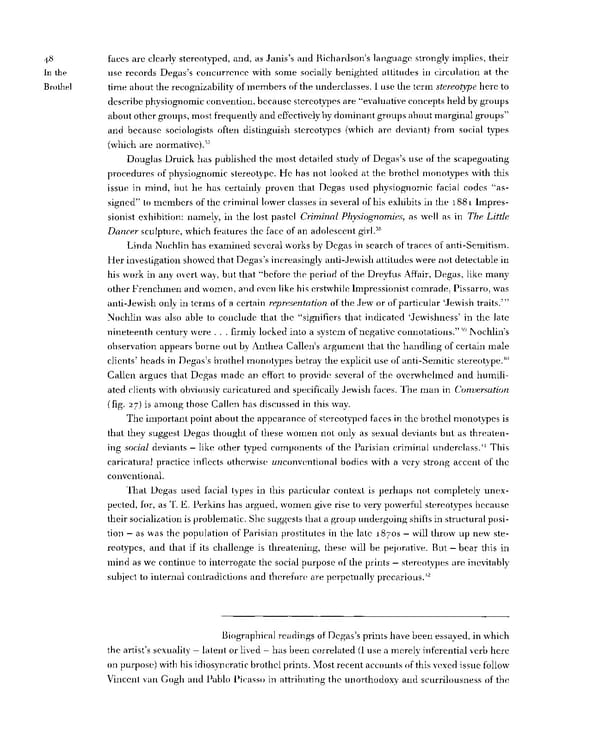48 faces are clearly stereotyped, and, as Janis's and Richardson's language strongly implies, their In the use records Degas's concurrence with some socially benighted attitudes in circulation at the Brothel time about the recognizability of members of the underclasses. I use the term stereotype here to describe physiognomic convention, because stereotypes are "evaluative concepts held by groups about other groups, most frequently and effectively by dominant groups about marginal groups" and because sociologists often distinguish stereotypes (which are deviant) from social types (which are normative).57 Douglas Druick has published the most detailed study of Degas's use of the scapegoating procedures of physiognomic stereotype. He has not looked at the brothel monotypes with this issue in mind, but he has certainly proven that Degas used physiognomic facial codes "as- signed" to members of the criminal lower classes in several of his exhibits in the 1881 Impres- sionist exhibition: namely, in the lost pastel Criminal Physiognomies, as well as in The Little Dancer sculpture, which features the face of an adolescent girl.38 Linda Nochlin has examined several works by Degas in search of traces of anti-Semitism. Her investigation showed that Degas's increasingly anti-Jewish attitudes were not detectable in his work in any overt way, but that "before the period of the Dreyfus Affair, Degas, like many other Frenchmen and women, and even like his erstwhile Impressionist comrade, Pissarro, was anti-Jewish only in terms of a certain representation of the Jew or of particular 'Jewish traits.'" Nochlin was also able to conclude that the "signifiers that indicated 'Jewishness' in the late nineteenth century were . . . firmly locked into a system of negative connotations."39 Nochlin's observation appears borne out by Anthea Calien's argument that the handling of certain male 40 clients' heads in Degas's brothel monotypes betray the explicit use of anti-Semitic stereotype. C alien argues that Degas made an effort to provide several of the overwhelmed and humili- ated clients with obviously caricatured and specifically Jewish faces. The man in Conversation (fig. 27) is among those C alien has discussed in this way. The important point about the appearance of stereotyped faces in the brothel monotypes is that they suggest Degas thought of these women not only as sexual deviants but as threaten- 41 ing social deviants - like other typed components of the Parisian criminal underclass. This caricatural practice inflects otherwise unconventional bodies with a very strong accent of the conventional. That Degas used facial types in this particular context is perhaps not completely unex- pected, for, as T. E. Perkins has argued, women give rise to very powerful stereotypes because their socialization is problematic. She suggests that a group undergoing shifts in structural posi- tion — as was the population of Parisian prostitutes in the late 18705 — will throw up new ste- reotypes, and that if its challenge is threatening, these will be pejorative. But — bear this in mind as we continue to interrogate the social purpose of the prints — stereotypes are inevitably 42 subject to internal contradictions and therefore are perpetually precarious. Biographical readings of Degas's prints have been essayed, in which the artist's sexuality — latent or lived — has been correlated (I use a merely inferential verb here on purpose) with his idiosyncratic brothel prints. Most recent accounts of this vexed issue follow Vincent van Gogh and Pablo Picasso in attributing the unorthodoxy and scurrilousness of the
 Prostitution & Impressionists Page 68 Page 70
Prostitution & Impressionists Page 68 Page 70